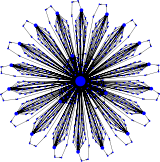Template:EvoLudo/Recent: Difference between revisions
No edit summary |
|||
| Line 1: | Line 1: | ||
[[Image:RSP - SDE.svg|160px|left|link=Stochastic dynamics in finite populations|Evolutionary trajectory in a finite population as generated by stochastic differential equations]] | [[Image:Superstar graph (N=484, B=21, k=6).svg|160px|left|link=Evolutionary graph theory]] | ||
=== [[Evolutionary graph theory]] === | |||
New tutorial added on [[evolutionary graph theory]], which provides a formal approach to describe the spreading and fixation (or extinction) of a mutant type in structured populations. Interestingly, the fixation probabilities remain unaffected by the underlying structure for a [[Moran graphs|large class of graphs]]. However, some graphs may act either as [[Evolutionary amplifiers|amplifiers]] or [[Evolutionary suppressors|suppressors]] of selection by increasing or decreasing the fixation probabilities as compared to unstructured populations. In contrast, fixation and absorption times are very sensitive to changes in the graph structure and hence vary greatly even for graphs that leave fixation probabilities unchanged. Even though fixation times are, in general, not preserved between graphs, [[Graph symmetries|symmetries of a graph]] can at least ensure that fixation times do not depend on the initial location of the mutant. This summarizes research efforts that span over a decade, including: | |||
<div class="footnote" style="font-size:smaller"> | |||
#McAvoy, A. & Hauert, C. (2015) ''J. R. Soc. Interface'' '''12''' 20150420 [http://dx.doi.org/10.1098/rsif.2015.0420 doi: 10.1098/rsif.2015.0420] | |||
#Jamieson-Lane, A. & Hauert, C. (2015) ''J. Theor. Biol.'' '''382''' 44-56 [http://dx.doi.org/10.1016/j.jtbi.2015.06.029 doi: 10.1016/j.jtbi.2015.06.029] | |||
#Lieberman, E., Hauert, C. & Nowak, M. (2005) ''Nature'' '''433''' 312-316 [http://dx.doi.org/10.1038/nature03204 doi: 10.1038/nature03204]. | |||
</div> | |||
<!--[[Image:RSP - SDE.svg|160px|left|link=Stochastic dynamics in finite populations|Evolutionary trajectory in a finite population as generated by stochastic differential equations]] | |||
===[[Stochastic dynamics in finite populations]]=== | ===[[Stochastic dynamics in finite populations]]=== | ||
New tutorial that complements a research article which establishes a transparent link between individual based simulations and the deterministic dynamics of the replicator equation through stochastic differential equations. | New tutorial that complements a research article which establishes a transparent link between individual based simulations and the deterministic dynamics of the replicator equation through stochastic differential equations. | ||
Traulsen, A., Claussen, J. C. & Hauert, C. (2012) Stochastic differential equations for evolutionary dynamics with demographic noise and mutations. ''Phys. Rev. E'' '''85''' 041901 [http://dx.doi.org/10.1103/PhysRevE.85.041901 doi: 10.1103/PhysRevE.85.041901] | Traulsen, A., Claussen, J. C. & Hauert, C. (2012) Stochastic differential equations for evolutionary dynamics with demographic noise and mutations. ''Phys. Rev. E'' '''85''' 041901 [http://dx.doi.org/10.1103/PhysRevE.85.041901 doi: 10.1103/PhysRevE.85.041901] | ||
--> | |||
Revision as of 11:49, 31 August 2016

Evolutionary graph theory
New tutorial added on evolutionary graph theory, which provides a formal approach to describe the spreading and fixation (or extinction) of a mutant type in structured populations. Interestingly, the fixation probabilities remain unaffected by the underlying structure for a large class of graphs. However, some graphs may act either as amplifiers or suppressors of selection by increasing or decreasing the fixation probabilities as compared to unstructured populations. In contrast, fixation and absorption times are very sensitive to changes in the graph structure and hence vary greatly even for graphs that leave fixation probabilities unchanged. Even though fixation times are, in general, not preserved between graphs, symmetries of a graph can at least ensure that fixation times do not depend on the initial location of the mutant. This summarizes research efforts that span over a decade, including:
- McAvoy, A. & Hauert, C. (2015) J. R. Soc. Interface 12 20150420 doi: 10.1098/rsif.2015.0420
- Jamieson-Lane, A. & Hauert, C. (2015) J. Theor. Biol. 382 44-56 doi: 10.1016/j.jtbi.2015.06.029
- Lieberman, E., Hauert, C. & Nowak, M. (2005) Nature 433 312-316 doi: 10.1038/nature03204.